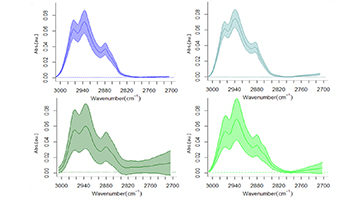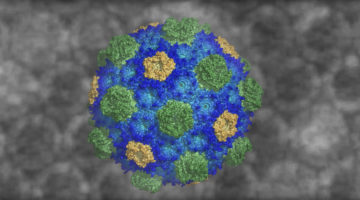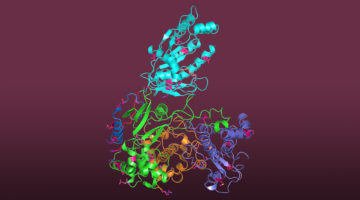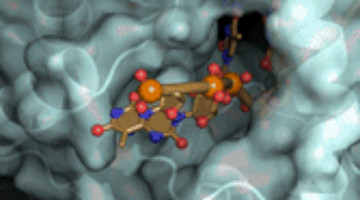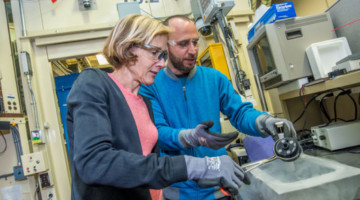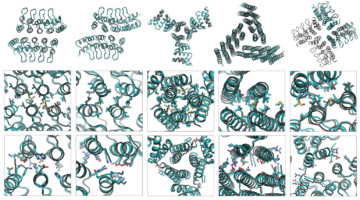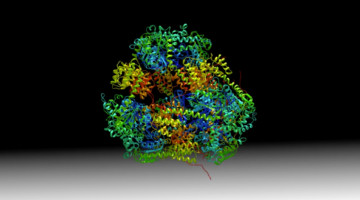Genetic analyses and infrared studies have found that archaea, a type of microbe commonly found in extreme environments, are also found on human skin. The results suggest that an increase in archaea is linked to reduced skin moisture and that they are most abundant in subjects younger than 12 and older than 60. Read more »
ALS Work Highlighted in DOE Top 40 Countdown
To celebrate DOE’s 40th anniversary (October 1, 2017), the Office of Science (SC) collected 40 scientific milestones from the previous 40 years, each one supported by SC. The ALS played a key role in two of the milestones: 2005 (ribosome) and 2009 (topological materials). Read more »
Global Blood Therapeutics Uses ALS to Tackle Sickle Cell Disease
Sickle cell disease (SCD), which affects millions of people worldwide, has traditionally been treated with a cytotoxic drug that has a range of negative side effects and variable patient response. Bay Area biopharmaceutical company Global Blood Therapeutics (GBT) is on a mission to develop a better treatment and is using the ALS to help. Read more »![]()
A Bacterial Jigsaw Puzzle Is Solved
Bacterial microcompartments (BMCs) are hollow protein shells that encapsulate enzymes involved in bacterial metabolism. Crystallography studies have provided atomic-resolution views of a fully assembled BMC, revealing basic principles of shell construction for fighting pathogens or bioengineering applications. Read more »![]()
![]()
Structure of a Key Protein from the Zika Virus
The Zika virus (ZIKV) is a mosquito-borne pathogen recently linked to birth defects in infants. At the ALS, researchers have resolved the structure of a key ZIKV protein to 3.0 Å, an important step toward the rational design of drugs capable of disrupting viral functions and halting the spread of the disease. Read more »![]()
![]()
Researchers ID New Mechanism for Keeping DNA Protein in Line
The actions of a protein used for DNA replication and repair are guided by electrostatic forces known as phosphate steering, a finding that not only reveals key details about a vital process in healthy cells, but provides new directions for cancer treatment research. Read more »
What’s On Your Skin? Archaea, That’s What
It turns out your skin is crawling with single-celled microorganisms—and they’re not just bacteria. A study by Berkeley Lab and the Medical University of Graz has found that the skin microbiome also contains archaea, a type of extreme-loving microbe, and that the amount of it varies with age. Read more »
Study Sheds Light on How Bacterial Organelles Assemble
Scientists are providing the clearest view yet of an intact bacterial microcompartment (BMC), revealing the polyhedral structure and assembly of this organelle’s protein shell. Having the full structure can help provide important information in fighting pathogens or bioengineering bacterial organelles for beneficial purposes. Read more »
A Systematic Approach to Customizing Cyclic Proteins
Proteins consisting of identical subunits arranged symmetrically around a central axis (cyclic homo-oligomers) play key roles in many biological processes. Researchers have now developed a systematic approach to their design and demonstrated its accuracy using protein crystallography and small-angle x-ray scattering. Read more »
A Hollow Pyramid Unlocks Principles of Protein Architecture
Researchers have designed a hollow, pyramid-shaped protein with a controllable cavity size that could be useful in the capture and release of smaller compounds. The tools and techniques developed could be useful in analyzing and optimizing designed protein assemblies and understanding their behavior in solution. Read more »
- « Previous Page
- 1
- …
- 16
- 17
- 18
- 19
- 20
- …
- 24
- Next Page »
